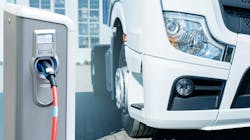Global freight demand is expected to grow over the next few decades and that means more trucks will be needed to deliver goods to consumers and businesses. That makes the need for zero-emissions vehicles even more important so that goods can be delivered without adding greenhouse gas emissions to the environment. Electric vehicles are one way to get goods delivered without harming the environment.
As we explore where electric vehicles make sense in North America, I think we should look at much of the rest of the world and learn from their efforts to get to zero emissions freight movement.
The ninth training in NACFE’s Electric Truck Bootcamp took a global perspective on EV developments. During the training, Oscar Delgado, manager, Zero-Emission Fleets Center, The International Council on Clean Transportation, reminded us that fleets are reluctant to change, and that total cost of ownership is a priority for them when looking at new technologies including EVs.
Dave Mullaney, principal, Carbon-Free Mobility, RMI, talked about EV deployment efforts in Shenzhen China. He explained that financial incentives, a change in ownership models, a public charging infrastructure, and improvements to vehicles all aided the growth of EVs in Shenzhen. The ownership model for about 90% of the EVs in Shenzhen is short-term rental and leasing. Mullaney said this helps eliminate some of the upfront equipment costs, is flexible, and provides after-sales support. During the initial EV deployments, the focus was on depot charging but that model did not work for small fleets and owner-operators. Today there are 80,000 public chargers in Shenzhen.
Cristiano Facanha, global director, CalStart, predicts that based on data from Europe EVs will reach cost parity with diesels by 2030 when looking at TCO including capital costs, maintenance costs, and operational costs. Eight countries have signed an MOU to pursue a global agreement on zero-emissions medium- and heavy-duty vehicles to align with the Paris Climate Accord, which I think is a sign of the importance governments are placing on reducing emissions across the globe.
According to Samhita Shiledar, manager, India Program, RMI, India is one of the fastest-growing economies with the freight sector growing at the rate of 6% and 70% of freight moved via roads. While the EV market is nascent in India, there are national and state-level policies to cultivate the EV ecosystem, including a directive form the Ministry of Power to have chargers every 25 kilometers. Declining battery costs, improvements in infrastructure and economies of scale will lead to cost parity, Shiledar said adding that if 70% of vehicles in India are electric by 2030 that would equal four million vehicles.
While each market has its unique characteristics, similarities can be found. For example, Shenzhen is a large dense city and is comparable to large dense cities in the US where battery range is not an issue. Shiledar added that EVs work best in cities and on predictable routes, which is a duty cycle that is common in the US too.
“Lessons learned in other parts of the world can be transferred across borders,” Mullaney said. And lessons learned in other duty cycles, like buses, can transfer as well, according to Delgado.
While we hope to learn a great deal from the 13 fleets participating in Run on Less – Electric, maybe it’s time we took a look outside our own borders to see how folks in other parts of the world are responding to the drive for zero emissions. You never know what you’ll learn when you expand your search. And I am betting that if the people working on EV deployment in other parts of the world are as passionate about helping scale EV use as the people here in the US, that they’ll be more than happy to chat with you.
Michael Roeth has worked in the commercial vehicle industry for nearly 30 years, most recently as executive director of the North American Council for Freight Efficiency. He currently serves on the second National Academy of Sciences Committee on Technologies and Approaches for Reducing the Fuel Consumption of Medium and Heavy-Duty Vehicles and has held various positions in engineering, quality, sales and plant management with Navistar and Behr/Cummins.
About the Author

Michael Roeth
Executive Director
Michael Roeth is the executive director of the North American Council for Freight Efficiency. He serves on the second National Academy of Sciences Committee on Technologies and Approaches for Reducing the Fuel Consumption of Medium and Heavy-Duty Vehicles and has held various positions with Navistar and Behr/Cummins.
